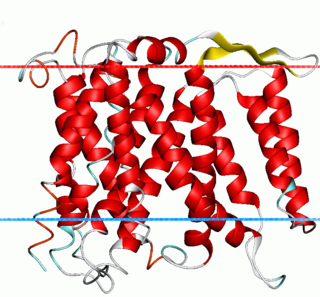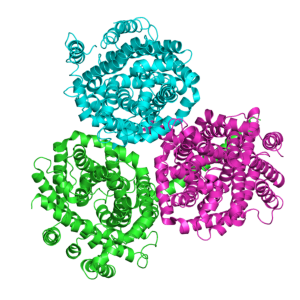Related Research Articles
The Transporter Classification Database is an International Union of Biochemistry and Molecular Biology (IUBMB)-approved classification system for membrane transport proteins, including ion channels.

The sodium–hydrogen antiporter or sodium–proton exchanger (Na+/H+ exchanger) is a membrane protein that transports Na+ into the cell, and H+ out of the cell (antiport).
An amino acid transporter is a membrane transport protein that transports amino acids. They are mainly of the solute carrier family.

Proteins of the Betaine/Carnitine/Choline Transporter (BCCT) family are found in Gram-negative and Gram-positive bacteria and archaea. The BCCT family is a member a large group of secondary transporters, the APC superfamily. Their common functional feature is that they all transport molecules with a quaternary ammonium group [R-N (CH3)3]. The BCCT family proteins vary in length between 481 and 706 amino acyl residues and possess 12 putative transmembrane α-helical spanners (TMSs). The x-ray structures reveal two 5 TMS repeats with the total number of TMSs being 10. These porters catalyze bidirectional uniport or are energized by pmf-driven or smf-driven proton or sodium ion symport, respectively, or else by substrate:substrate antiport. Some of these permeases exhibit osmosensory and osmoregulatory properties inherent to their polypeptide chains.

Members of the Solute:Sodium Symporter (SSS) Family (TC# 2.A.21) catalyze solute:Na+ symport. The SSS family is within the APC Superfamily. The solutes transported may be sugars, amino acids, organo cations such as choline, nucleosides, inositols, vitamins, urea or anions, depending on the system. Members of the SSS family have been identified in bacteria, archaea and eukaryotes. Almost all functionally well-characterized members normally catalyze solute uptake via Na+ symport.
The amino acid-polyamine-organocation (APC) superfamily is the second largest superfamily of secondary carrier proteins currently known, and it contains several Solute carriers. Originally, the APC superfamily consisted of subfamilies under the transporter classification number. This superfamily has since been expanded to include eighteen different families.
Members of the Alanine or Glycine:Cation Symporter (AGCS) Family (TC# 2.A.25) transport alanine and/or glycine in symport with Na+ and or H+.
Divalent anion:Na+ symporters were found in bacteria, archaea, plant chloroplasts and animals.
The ion transporter (IT) superfamily is a superfamily of secondary carriers that transport charged substrates.
The arsenical resistance-3 (ACR3) family is a member of the BART superfamily. Based on operon analyses, ARC3 homologues may function either as secondary carriers or as primary active transporters, similarly to the ArsB and ArsAB families. In the latter case ATP hydrolysis again energizes transport. ARC3 homologues transport the same anions as ArsA/AB homologues, though ArsB homologues are members of the IT Superfamily and homologues of the ARC3 family are within the BART Superfamily suggesting they may not be evolutionarily related.
The NhaB family belongs to the ion transporter (IT) superfamily. A representative list of proteins belonging to the NhaB family can be found in the Transporter Classification Database.
The NhaC family belongs to the Ion Transporter (IT) Superfamily. A representative list of proteins belonging to the NhaC family can be found in the Transporter Classification Database.
The NhaD family belongs to the Ion Transporter (IT) Superfamily. A representative list of proteins belonging to the NhaD family can be found in the Transporter Classification Database.
The NhaE family belongs to the Ion Transporter (IT) Superfamily, which has an end. A representative list of proteins belonging to the NhaE family can be found in the Transporter Classification Database.

The Monovalent Cation:Proton Antiporter-1 (CPA1) Family (TC# 2.A.36) is a large family of proteins derived from Gram-positive and Gram-negative bacteria, blue-green bacteria, archaea, yeast, plants and animals. The CPA1 family belongs to the VIC superfamily. Transporters from eukaryotes have been functionally characterized to catalyze Na+:H+ exchange. Their primary physiological functions are thought to be in (1) cytoplasmic pH regulation, extruding the H+ generated during metabolism, and (2) salt tolerance (in plants), due to Na+ uptake into vacuoles. Bacterial homologues have also been found to facilitate Na+:H+ antiport, but some also catalyze Li+:H+ antiport or Ca2+:H+ antiport under certain conditions.
The Monovalent Cation:Proton Antiporter-2 (CPA2) Family is a moderately large family of transporters belonging to the CPA superfamily. Members of the CPA2 family have been found in bacteria, archaea and eukaryotes. The proteins of the CPA2 family consist of between 333 and 900 amino acyl residues and exhibit 10-14 transmembrane α-helical spanners (TMSs).
The Monovalent Cation (K+ or Na+):Proton Antiporter-3 (CPA3) Family (TC# 2.A.63) is a member of the Na+ transporting Mrp superfamily. The CPA3 family consists of bacterial multicomponent K+:H+ and Na+:H+ antiporters. The best characterized systems are the PhaABCDEFG system of Sinorhizobium meliloti (TC# 2.A.63.1.1) that functions in pH adaptation and as a K+ efflux system, and the MnhABCDEFG system of Staphylococcus aureus (TC# 2.A.63.1.3) that functions as a Na+ efflux Na+:H+ antiporter.
The Malonate:Na+ Symporter (MSS) Family (TC# 2.A.70) is a group of transport proteins belonging to the CPA superfamily. These proteins are composites with constituents ranging in size from 129 to 255 amino acyl residues (aas) and exhibiting 4 to 7 transmembrane segments (TMSs). A representative list of proteins belonging to the MSS family can be found in the Transporter Classification Database.
The Putative Sulfate Exporter (PSE) Family (TC# 2.A.98) is composed of several putative 10 or 11 transmembrane segment (TMS) proteins. This family is part of the CPA superfamily and its members are found in diverse bacteria and archaea. The genes encoding some of these homologues may be induced by growth in the presence of cysteate (suyZ) or taurine (tauZ). Although they differ in structure, these proteins are most closely related to the 12 TMS members of the CPA superfamily and exhibit demonstrable homology to the MadML malonate:H+ symporter (TC #2.A.70), although their sequence similarity is low.
The Na+-transporting Carboxylic Acid Decarboxylase (NaT-DC) Family (TC# 3.B.1) is a family of porters that belong to the CPA superfamily. Members of this family have been characterized in both Gram-positive and Gram-negative bacteria. A representative list of proteins belonging to the NaT-DC family can be found in the Transporter Classification Database.
References
- 1 2 "2.A.37 The Monovalent Cation:Proton Antiporter-2 (CPA2) Family". Transporter Classification Database.
- ↑ Chen, Jonathan S.; Reddy, Vamsee; Chen, Joshua H.; Shlykov, Maksim A.; Zheng, Wei Hao; Cho, Jaehoon; Yen, Ming Ren; Saier, Milton H. Jr. (2011). "Phylogenetic Characterization of Transport Protein Superfamilies: Superiority of SuperfamilyTree Programs over Those Based on Multiple Alignments". Journal of Molecular Microbiology and Biotechnology. 21 (3–4): 83–96. doi:10.1159/000334611. PMC 3290041 . PMID 22286036.
- ↑ Koishi, Ryuta; Xu, Haoxing; Ren, Dejian; Navarro, Betsy; Spiller, Benjamin W.; Shi, Qing; Clapham, David E. (2004-03-05). "A superfamily of voltage-gated sodium channels in bacteria". The Journal of Biological Chemistry. 279 (10): 9532–9538. doi: 10.1074/jbc.M313100200 . ISSN 0021-9258. PMID 14665618.
- ↑ "1.A.1 The Voltage-gated Ion Channel (VIC) Superfamily". Transporter Classification Database. Retrieved 2016-04-05.
- ↑ "2.A.70 The Malonate:Na+ Symporter (MSS) Family". Transporter Classification Database.
- ↑ "2.A.98 The Putative Sulfate Exporter (PSE) Family". Transporter Classification Database.
- ↑ "3.B.1 The Na+-transporting Carboxylic Acid Decarboxylase (NaT-DC) Family". Transporter Classification Database.
As of this edit, this article uses content from "Search: CPA Superfamily << TCDB" , which is licensed in a way that permits reuse under the Creative Commons Attribution-ShareAlike 3.0 Unported License, but not under the GFDL. All relevant terms must be followed.